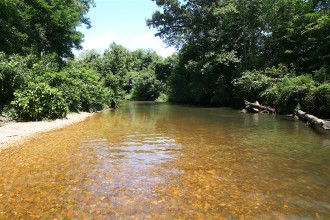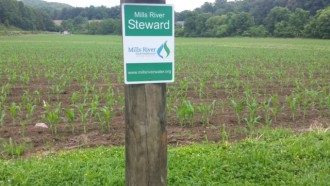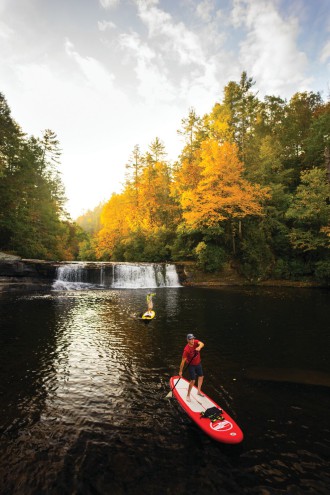Not so long ago, the French Broad and its tributaries powered the economy of Western North Carolina by transporting goods, generating electricity and whisking away industrial pollutants. These days, the economic value of the river depends more and more on the overall health of the waterway, whether for the drinking water it supplies to over 1 million people, the region’s booming beer industry, or attracting tourists and new residents.
That shift is driving a small army of local government workers, environmental organizations and residents to continue and expand efforts to improve the quality of the river’s water. While much has changed for the better over the past several decades, much remains to be done: The river still runs muddy brown after hard rains, and negative stereotypes and rumors about its water quality persist on social media and by word of mouth.
In this two-part series, Xpress invites you on a guided a trip down the river as we examine the work of various communities to write the next chapter in the French Broad’s history. This week, we’ll explore the upper sections of the river that flow northward through Transylvania and Henderson counties.
Birth of a river
A handpainted wooden sign about the size of a phone book marks ‘mile zero’ of the river’s journey through WNC, just outside the town of Rosman. Headwaters Outfitters, owned and operated by David and Debi Whitmire, sits besides this sign at the confluence of the river’s north and west forks.
David Whitmire, whose family roots along the French Broad go back to the 1820s, says the river played a large role in his upbringing. “My grandfather would drop us boys off, and pick us up at the bottom of the run,” he says. “The confluence here was always a popular place to sit back and wormfish when you were a kid.”

In many ways, the growth of Headwaters Outfitters mirrors the French Broad’s revitalization over the past three decades. From its modest start with “a little eight-passenger van and about 10 canoes” in 1992, Whitmire says Headwaters now boasts a fleet of about 70 boats. The outfitter offers tube, kayak and canoe rentals out of its bustling, full-service retail store. There’s even the obligatory taproom.
Through it all, Whitmire says he’s made sure his customers know the significance of the river they’re on. “This is mile marker 0; you’re doing the first 8-10 miles of a beautiful old river — the third-oldest river in the world,” he says with pride.
A gentler current
Unlike the rock-strewn whitewater of the river’s lower sections near Asheville, the Upper French Broad babbles placidly through a mostly rural setting. Away from industry and residential neighborhoods, this stretch of the river has escaped some of the water quality issues that have plagued sections that pass through more populated areas downstream.
Even so, human activity has impacted the upper reaches of the river through the years. Loose soils — the result of agriculture, tree cutting and grading — along the riverbank often lead to trees falling into the waterway during heavy rains, says Whitmire.
In addition, sediment runoff from surrounding farms and development projects can turn the French Broad into a muddy brown soup after significant rainfall. The sediment can literally suffocate aqueous wildlife and introduce harmful bacteria into the water, according to Landon Davidson, regional supervisor for the N.C. Department of Water Quality.
“Nonpoint source pollutants [such as sediment, nutrient runoff, and bacteria] remain the most significant threat to water quality and aquatic habitats in the watershed,” says Davidson, whose department monitors 22 stations in the French Broad watershed.
While the department works with partner organizations and communities across Western North Carolina to develop and implement plans for managing runoff, its efforts are often limited by a small budget and lack of manpower, according to many of those interviewed for this article.
“The scope of our program spans from overseeing coal ash residuals cleanup, inspecting all sizes of wastewater treatment facilities, permitting sewer extensions, permitting injection wells, regulating animal operations, responding to complaints and emergencies impacting water quality, managing groundwater contamination incidents, and more,” says Davidson. The department’s 15-person staff oversees 19 counties in Western North Carolina.
In our blood
With regulators’ resources strained, local environmental groups have stepped in to take up the slack, forming a chain of organizations that span the entire length of the French Broad and many of its tributaries.

The Whitmires, for instance, helped found the Transylvania French Broad Stewards in 2014. The organization provides updates on river conditions, shares information on the French Broad for tourists and residents, and organizes events like the annual Upper French Broad River Fest in Rosman.
“We do free tube rides for the kids and that kind of stuff. It also helps us with asking for money from the county for river cleanups,” Whitmire says of the festival. “We’re just trying to get local individuals focused.”
Farther downstream, where the French Broad joins with several major tributaries — the Mills and Little rivers, Cane Creek, and the aptly named Mud Creek — groups like the Mills River Partnership, a coalition of local stakeholders, focus on keeping the water entering the French Broad as pristine as possible.
Besides its role as a major tributary to the French Broad south of Asheville, the Mills River supplies the region with a significant portion of its drinking water. “This intake plant feeds all of Hendersonville,” says Maria Wise, pointing to a collection of pipes and pumps that jut out into the Mills near its intersection with U.S. Highway 280. A second, smaller plant several miles downstream supplies 16 to 20 percent of the water Asheville uses, she adds.
Like Whitmire, Wise can trace her interest in the French Broad to a childhood spent along its banks. The Madison County native currently serves as watershed coordinator for the Mills River Partnership. “My older brother was a riverkeeper in Virginia for a few years, and my dad worked for the cooperative extension and was on the soil and water board. An interest in the land and the water is in our blood.”
Washed away
While Mills River is known for being one of the cleanest of the French Broad tributaries, sediment entering the waterway from adjacent agricultural fields and residential developments is an ongoing concern, according to Wise.
In addition to degrading water quality, erosion can severely impact a farmer’s land. Mills River Partnership works with local farmers to install grass waterways — strips of uncultivated land which provide a spillway for excess rainwater — in fields adjacent to creeks and streams feeding into the Mills, says Wise.
“You would be surprised how much water will run off of this field in a heavy rainstorm,” she says, pointing to a cornfield several hundred feet from the Mills. “The farmer was losing a lot of corn and incredible amounts of topsoil.”
In addition to the grassways, volunteers plant “live stakes” to reinforce and strengthen the riparian zones along creeks. “We want all these streams to be completely inundated with plants and trees and shrubs,” Wise says, “because they’re taking up the sediment and filtering it out. The more filtering that can be done all along the way, the better.”

Something for everyone
Balancing the health of local streams with the economic realities of those who live along them is key to ensuring cooperation on any river-related project. “We don’t want to change the way people have done business and lived along the river,” says Whitmire. “We embrace the cultures that were here first, and I think that’s important to try to maintain those things. A lot of those families have been there, like mine, for seven generations or so.”
Economic incentives, Wise says, help local farmers justify participation in water quality improvement projects. “In almost all cases, you can find an economic angle, where it’s helping their operation on some level,” she says. “The farmers are putting up some of their money with every project, so it is important to recognize their efforts.”
Mills River Partnership also works to educate the surrounding community on the relationship between farming and water quality, and to dispel negative perceptions of farming’s impact on the French Broad watershed.
“People say agriculture is contributing a lot [of contaminants], but they don’t really understand how that works,” notes Wise. “A lot of our education is explaining farming practices to the general public, so they understand what everyone’s up against, and reminding them how many problems are coming from residential development, too.”
Fishing for filth
Progressing downstream along the river’s course toward Asheville, the impact of human population on the waterway increases.
“As you move downstream, the data indicates the increased impact from human activity as turbidity, nutrient, temperature, [and] specific conductivity increase,” Davidson says. ”Many of these tributaries are flowing through towns and developed areas along the river.”
A 2016 map produced by the N.C. Department of Water Quality identifies at least 10 “impaired” sections of waterways in Transylvania and Henderson counties. One glaring example is Mud Creek, which winds through Hendersonville along Interstate 26. In addition to the sediment that gives the creek its name, refuse from storm drains and roadways also finds its way into the water after heavy storms.
“The storm drains pick up the litter on the sides of the roads and pipe it to the closest creek,” says Eric Bradford of the environmental nonprofit Asheville Greenworks, which works throughout the French Broad watershed. Once the trash gets into the water, he adds, it can degrade into tiny pieces which can enter the food chain all the way to the Gulf of Mexico.

To help capture this waste before it enters the French Broad, Asheville Greenworks recently partnered with the city of Hendersonville to install a “trash trout” along Mud Creek. Since its implementation on June 8, the device has yielded eye-opening results. “We got about 230 pounds of trash from one recent rainstorm,” Bradford reveals.
The volume of trash collected in devices like the trash trout helps quantify the amount of litter that washes down tributaries over time. “You look out in the river, you might see a cup float by, and think it’s not a big deal,” Bradford says. “But now, we’re capturing it for you, so you can actually see all that trash that floated past in that rain event.”
Ecology meets economy
A clean river also means a vibrant economy. River access points have been added at Etowah, Horse Shoe and Mills River in recent years. In addition to Headwaters Outfitters, Lazy Otter Outfitters opened in 2016 to expose kayakers, tubers and fishing enthusiasts to the sections of the river between Brevard and Asheville.
The French Broad Paddle Trail, launched in April of 2012 with the support of environmental nonprofits RiverLink and MountainTrue, Oskar Blues Brewery and other local sponsors, allows boaters to travel complete sections of the river, with the opportunity to stop at local restaurants and campgrounds along the way. “It connects us to Asheville in a neat way, because people start here and end up there,” says Whitmire.
Breweries are also flocking to the water’s edge. Sierra Nevada Brewing Co., for example, invested over $100 million in its Mills River facility and employs more than 100 people. In Brevard, Oskar Blues has partnered with city government on the Cherry Street Greenway project. The beer maker attracts thousands of visitors to Transylvania County each year with its taproom and special events like the Burning Can Festival.

“Brewers are inherently connected to our watersheds as the health of that watershed directly impacts the main ingredient in beer: water,” says Sierra Nevada’s sustainability manager Cheri Chastain. “Our stormwater management efforts include permeable surfaces to allow rainwater to percolate back into the aquifer, rain water collection from both rooftops and paved surfaces, bioswales to collect heavy flows of water, and an engineered stream to take the excessive amounts of rainwater that occur. All of these measures help to recharge the aquifer that we are pulling our brewing water from and slow the flow of rain water headed to the French Broad.”
Trails like the Oklawaha Greenway, which runs along Mud Creek in Hendersonville, also spotlight the status of the waterway. “It’s putting a lot of pressure and focus on keeping Mud Creek in good condition,” says Michael Arrowood of the Henderson County Tourism Development Authority.
Still in the planning stages, the proposed Ecusta Trail would travel through the French Broad River valley from Hendersonville to Brevard along U.S. Highway 64. The Ecusta trail and a new nature area at Fletcher Community Park on Cane Creek are both expected to draw visitors by highlighting the beauty of the river corridor.
“The trails and people are going down towards the river,” says Arrowood. “The more time people spend on the river, the more they say they want this to be clean. It all ties in.”
Herons and hellbenders
The abundance of wildlife along the French Broad is both a consequence and a sign of the river’s improved health. According to RiverLink, the French Broad watershed is believed to have one of the largest great blue heron populations in the world. “You can’t go on the river now and not see several blue herons,” says Wise. “They were not there when I was a kid.”
In addition, the French Broad is home to rare flora and fauna, from the carnivorous Mountain sweet pitcher plant and the Appalachian elktoe mussel to the tiny bog turtle and prehistoric hellbender salamander. “That’s our canary in the mine there, so to speak,” says Whitmire of the hellbender, “because it requires excellent water conditions, since they breathe through their skin.”
A healthy wildlife habitat can also serve as yet another way to attract people to the river, he adds. “If you’re a birder and haven’t enjoyed the French Broad valley: The diversity of birds is incredible,” Whitmire notes. “And these are great native trout waters. The fishing industry itself generates a huge amount of tourism dollars that come into the county and to the western part of the state.”

Statistics gathered by the Department of Water Quality have shown a large improvement in water quality in the French Broad basin over the past 30 years, according to Davidson. “Overall data trends show the progress in reducing contaminants such as fecal coliform bacteria,” he says. “There is also much less industrial activity in the basin and better management of both point and nonpoint source pollutants.”
River on the rebound
While encouraging signs of progress abound, river advocates on the Upper French Broad say new challenges lurk on the horizon. Whitmire points to the recent die-off of native hemlocks as an issue river advocates will likely need to contend with in the coming years. “They’re standing now, but they’re standing dead,” he notes. “We’re just seeing part of the tip of what’s going to be flowing down that river.”
Along the Mills River tributary Foster Creek, Mills River Partnership is hoping to team up with Living Web Farms on a streambank restoration initiative next year. In addition, the farm is researching crops that can be planted in creekside areas.
With arable land scarce in the mountains, Wise explains, farmers have long resisted the idea of leaving prime agricultural acreage in the bottomlands fallow to provide a buffer between farming uses and waterways. Wise hopes new options for crops that can make money for farmers while protecting water quality will be identified.
“If we can really make a good case for some value-added crops that can be grown in the riparian zone, that’s benefitting everyone,” she says.
Most importantly, says Davidson, residents, businesses, and nonprofit groups must continue to spread awareness of the French Broad watershed as a public asset, one all should take steps to protect.
“The waters of the French Broad are owned by you, the citizens of North Carolina, the same individuals that can affect the greatest impact on the system for better or for worse,” Davidson advises. “If you use the river to recreate or understand its aesthetic and economic contribution to our region, take an active role in advocating for its protection.”
Next week: A look at the French Broad’s renaissance in Buncombe and Madison County.



Before you comment
The comments section is here to provide a platform for civil dialogue on the issues we face together as a local community. Xpress is committed to offering this platform for all voices, but when the tone of the discussion gets nasty or strays off topic, we believe many people choose not to participate. Xpress editors are determined to moderate comments to ensure a constructive interchange is maintained. All comments judged not to be in keeping with the spirit of civil discourse will be removed and repeat violators will be banned. See here for our terms of service. Thank you for being part of this effort to promote respectful discussion.